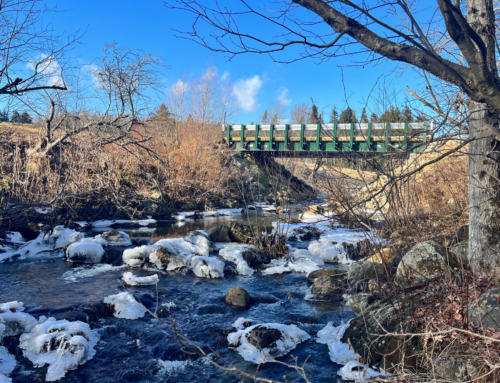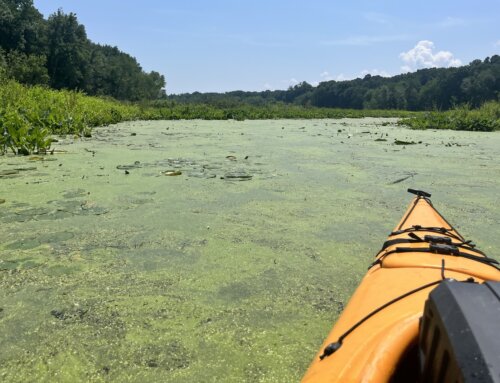Vermont. June 1, 2011. When you hear the word exotic you think of faraway places, different cultures, unusual food unless of course you are considering exotic flora or fauna then from an ecological point of view, exotic has a decidedly negative connotation. The way exotics get from one place to another is by a vector, defined as a carrier or a bearer and in most cases the vector is human. There are no treatments once exotics are in our waters. Preventing the spread of exotics is our only useful tool.
As we begin the boating season the Connecticut River Watershed Council is asking all boaters to help protect the Connecticut River from invasions of exotic plants and animals. Boaters, whether power boaters, canoers or sail enthusiasts are all possible vectors for the spread of aquatic plants and animals so boaters and fishers have a special responsibility to protect the aquatic habitat of the Connecticut River. Being responsible is not a difficult task for boaters. Just think: Check, Clean, or Dry!
When plant or fish exotics establish themselves in a new habitat they crowd out native species. They also create problems for humans, just ask anyone living on a waterbody where Eurasian milfoil or water chestnut has taken hold and choked their lake.
We also face a potential invasion of the infectious virus Viral Hemorrhagic Septicemia, called VHS discovered just to the west of Vermont with one scary false report last year from Lake Champlain. VHS has the potential to kill fish by the thousands. Because of the 3 year incubation period, the virus is spread unknowingly by moving seemingly healthy fish from one water body to another. Fishers should heed the restrictions on moving untested uncertified bait fish between water bodies including those you net yourself.
If you buy bait know where it came from, what species it is and whether or not it is a native to the body of water where you are fishing. The introduction of the wrong species of baitfish into a water body can have devastating effects on the resident fish; smelt in Lake Champlain is our latest invasion. Smelt are a bait fish eaten by the top predators but the smelt lack certain nutrients necessary for successful spawning of those predator fish.
Three years ago we discovered the invasive algae Didymosphenia geminata, better known as didymo or rock snot in the northern Connecticut River. Didymo has since spread to several new rivers and in each it can destroy river bottom habitat and make our watershed unappetizing to fish or swim in. Fishers wearing felt bottom waders are the vector that poses the major risk of transporting this invasive to new water. Soak waders in hot soapy water for 20 minutes or completely dry them out before going into new waters. Vermont has now banned the use of felt soled waders in all of their waters.
It does not matter if the waterbody is known to harbor exotics, act as though every place you launch contains these problem species. All of us should just think: Check, Clean or Dry!
Check: At the ramp during both launching and trailering thoroughly inspect your boat’s hull, drive unit, trim plates, trolling plates, prop guards, transducers, anchor, anchor rope and trailer. Scrape off and trash any suspected mussels, however small. Remove all waterweeds hanging from boat or trailer.
Clean: Before launching your boat into uninfected waters, thoroughly flush the hull, drive unit, live wells and the pumping system, bilge, trailer, bait buckets, engine cooling water system, and other boat parts that got wet while in infested waters. Use a hard spray from a garden hose or tow the boat through a do-it-yourself carwash. Do not use chlorine bleach or other environmentally unsound washing solutions next to the shore.
Drain all bilge water, live wells; bait buckets and any other water from your boat and equipment at the ramp as you leave a water body. Live bait should not be taken from one water body to another. Do not dump live bait into the water; the bait may be a non-native species to that waterbody. Hot water pumped through an engine’s intake periodically is one method of preventing zebra mussel transport inside an engine’s cooling system.
In order to kill didymo felt soled waders need 20 minutes in hot (140 degrees) soapy water (5% solution – 8oz of detergent in 1.25 gallons of water). This is greater concentration than what you use to do dishes.
Dry: If washing or disinfection steps cannot be taken then boats, trailers or waders should be allowed to dry thoroughly in the sun for up to 5 days before going into new waters. With waders if they are placed in the sun, 5 days should do it. If they are in a dark cool place it will take longer.
Enjoy our great river but don’t you be a vector this season. Be careful and protect our watershed from further invasions by exotics. Remember: Check, Clean or Dry!
# # # # #
David Deen is River Steward for the Connecticut River Watershed Council. CRC has been a protector of the Connecticut River for more than half a century.







